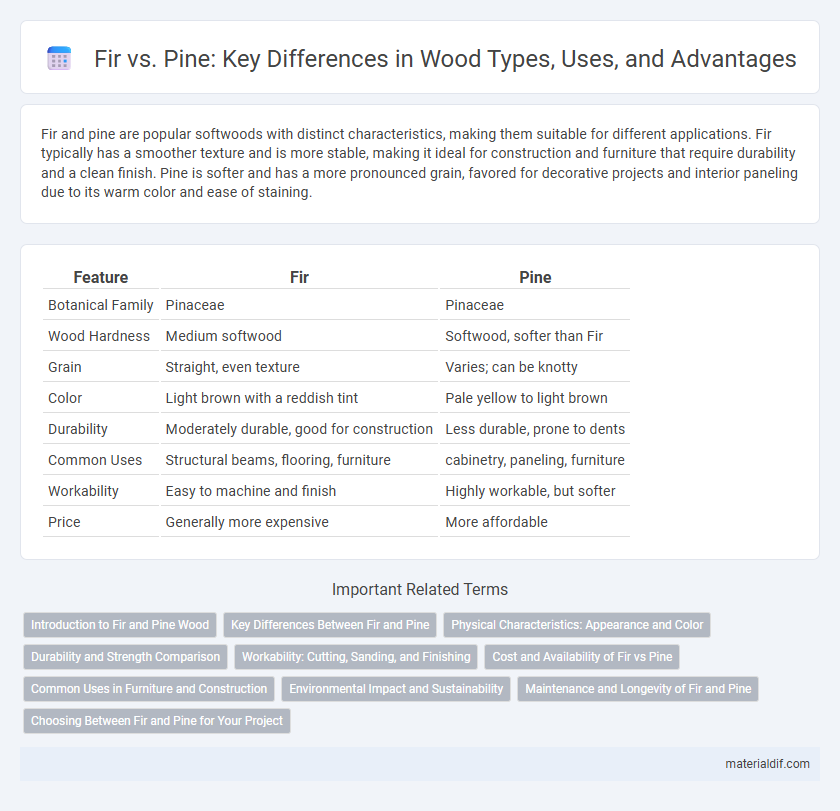Fir and pine are popular softwoods with distinct characteristics, making them suitable for different applications. Fir typically has a smoother texture and is more stable, making it ideal for construction and furniture that require durability and a clean finish. Pine is softer and has a more pronounced grain, favored for decorative projects and interior paneling due to its warm color and ease of staining.
Table of Comparison
| Feature | Fir | Pine |
|---|---|---|
| Botanical Family | Pinaceae | Pinaceae |
| Wood Hardness | Medium softwood | Softwood, softer than Fir |
| Grain | Straight, even texture | Varies; can be knotty |
| Color | Light brown with a reddish tint | Pale yellow to light brown |
| Durability | Moderately durable, good for construction | Less durable, prone to dents |
| Common Uses | Structural beams, flooring, furniture | cabinetry, paneling, furniture |
| Workability | Easy to machine and finish | Highly workable, but softer |
| Price | Generally more expensive | More affordable |
Introduction to Fir and Pine Wood
Fir wood, derived from trees in the Abies genus, is known for its strength, straight grain, and light color, making it a popular choice for construction and woodworking projects that require durability and smooth finishes. Pine wood, sourced from various species in the Pinus genus, is characterized by its softness, ease of workability, and distinct knots, often used in furniture, flooring, and paneling due to its warm tones and affordability. Both fir and pine are softwoods but differ in density and grain patterns, influencing their applications in carpentry and design.
Key Differences Between Fir and Pine
Fir wood is characterized by its lighter color, straight grain, and smooth texture, making it ideal for construction and furniture that requires a refined finish. Pine wood typically features a more prominent grain pattern, knots, and a yellowish hue, contributing to its popularity in rustic furniture and cabinetry. Fir offers greater strength and stability, while pine is softer and easier to work with, affecting their suitability for various woodworking projects.
Physical Characteristics: Appearance and Color
Fir wood typically features a light reddish-brown hue with a fine, uniform texture and straight grain, offering a smooth and clean appearance. Pine wood often displays a pale yellow to light brown color with distinct knots and a more pronounced grain pattern, contributing to a rustic and varied look. Both woods have softwood properties but differ notably in color intensity and grain consistency.
Durability and Strength Comparison
Fir wood exhibits higher durability and greater strength compared to pine, making it more suitable for structural applications requiring long-lasting support. Its dense grain and natural resistance to wear contribute to enhanced load-bearing capacity and reduced susceptibility to dents or damage. In contrast, pine is softer and less durable, often used for decorative purposes or light construction where strength is less critical.
Workability: Cutting, Sanding, and Finishing
Fir wood offers excellent workability with smooth cutting and easy sanding due to its straight grain and uniform texture, making it ideal for precise woodworking projects. Pine, while also easy to cut and sand, tends to have a softer texture that can be prone to denting and requires more careful finishing to avoid blotching. Both woods accept finishes well, but fir's tighter grain provides a more consistent surface for staining and varnishing.
Cost and Availability of Fir vs Pine
Fir is generally more expensive than pine due to its denser grain and better durability, making it a preferred choice for structural applications. Pine is widely available and more affordable, often used for furniture and interior finishes because of its lighter weight and ease of working. Availability of both woods varies regionally, but pine typically dominates the market due to faster growth rates and widespread plantations.
Common Uses in Furniture and Construction
Fir wood is commonly used in construction due to its strength, straight grain, and resistance to warping, making it ideal for framing and structural purposes. Pine, prized for its lighter weight and softer texture, is frequently selected for furniture making, cabinetry, and decorative elements where easier machining and a smooth finish are advantageous. Both woods offer versatility, but Fir dominates in durability for construction, while Pine is preferred for aesthetic and craft-oriented furniture projects.
Environmental Impact and Sustainability
Fir wood generally has a smaller environmental footprint than pine due to its faster growth rate and higher carbon sequestration capacity, making it a more sustainable choice for forestry. Pine trees, while also renewable, often require more intensive management practices and chemical treatments that can negatively affect soil health and biodiversity. Sustainable sourcing certifications such as FSC and PEFC are crucial for both fir and pine to ensure responsible harvesting and minimize ecological damage.
Maintenance and Longevity of Fir and Pine
Fir wood offers moderate maintenance needs with natural resistance to decay, making it suitable for indoor applications, while pine requires more frequent treatments to prevent insect damage and moisture effects. Pine's softer texture can lead to quicker wear, demanding regular sealing or staining to enhance its durability compared to fir. The longevity of fir typically exceeds pine when properly maintained, with fir lasting up to 20-25 years outdoors, whereas pine may last around 10-15 years depending on environmental exposure.
Choosing Between Fir and Pine for Your Project
Fir offers superior strength and stability, making it ideal for structural applications such as framing and beams. Pine provides a softer texture and lighter color, which is preferred for interior furniture and decorative elements. Selecting between fir and pine depends on project requirements for durability versus aesthetic appeal and ease of workability.
Fir vs Pine Infographic

 materialdif.com
materialdif.com